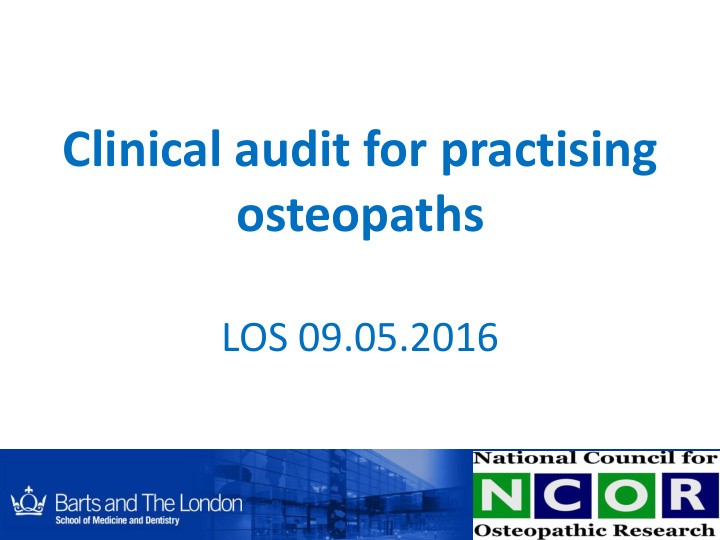



Clinical audit for practising osteopaths LOS 09.05.2016
What is clinical audit? It has been described as a technique to “assess, evaluate, and improve the care of patients in a systematic way to enhance their health and quality of life” 1 .
How has audit developed? Historical background Medical Audit Clinical Audit Clinical Governance
Types of audit Donabedian, 1980. Audits of structure; Audits of process; Audits of outcome.
The audit cycle Re-audit, and Select a record your meaningful findings in an topic audit report Analyse your Review the data, identify literature, and changes, and agree standards implement and criteria those changes Plan your audit, devise and pilot a data collection tool, and collect data
Research, audit, and data collection What are the similarities and differences? Research Data collection Audit (http://www.ncor.org.uk/practitioners/audit/)
Select a meaningful topic Structure Process Outcome
Review the literature Criteria Standards Existing audit tools
What is a criterion? Criteria are elements of care that can be defined and measured by clinicians. They provide clear examples of what aspects of practice are important.
What is a standard? “A criterion with its expected level of performance” Samuel et al, 1993
Searching the literature PubMed http://www.ncbi.nlm.nih.gov/pubmed Stanford High Wire http://highwire.stanford.edu/
Literature searching http://www.ncor.org.uk/learning- online/evidence-based-tutorials/ http://www.ncor.org.uk/learning- online/critical-appraisal/
Plan your audit Clear audit topic Why is this important? Roles and responsibilities Time scale Analysis – who and how Making changes Sources of help
Collecting data Audit tool Piloting and modification Sample size and sampling Data protection Patient awareness
Analyse your data Choose how to do this; Identify changes that you want to make; Identify how you want to make changes; Identify a timescale and who needs to be involved.
Next steps Time for changes to take effect; Re-audit; Compile your findings in an audit report.
Any questions?
Audit of clinic notes
Audit plan • Audit of patient case notes from 2005 onwards; • Criteria; • Standards; • Sampling
Literature search Pub Med: 1. case note* OR patient record* 2. AND standard* Google search: record keeping + NHS guidelines
Standards and criteria used Criteria: All case notes should include the information listed in the Osteopathic Practice Standards (2012) (https://www.osteopathy.org.uk/uploads/os teopathic_practice_standards_public.pdf); All case notes should meet standards of good practice identified in NHS guidelines.
Standards selected 100% of selected case notes should include the information listed in the Osteopathic Practice Standards (2012); 100% of selected case notes should meet standards of good practice identified from NHS guidelines.
Collecting data Audit tool (http://www.ncor.org.uk/practitioner s/audit/clinical-audit-tools/) Piloting and modification Sample size and sampling Data protection
Audit item 1 2 3 4 5 1. Are the records written in black ink? 2. Is the patient’s name written on every page? 3. Has the patient’s address been recorded? 4. Has the postcode been recorded? 5. Has a contact telephone number been recorded? 6. Has the name of the patient’s GP been recorded? 7. Has the GP practice address been recorded? 8. Has information about the presenting complaint been recorded? 9. Has the patient’s family history been recorded? 10. Has the patient’s prescribed medication been recorded?
Analysis
Identifying changes A new case note sheet was devised specifically listing the headings in the GOsC Practice Standards All pens other than black ones were removed from the practice
Re-audit
Any questions?
Practice audit
Literature search Pub Med search and Google search http://www.cqc.org.uk/organisations -we-regulate/registering-first- time/essential-standards Local authority websites; Infection control nurses association.
Planning the audit Identify a specific date; Select a colleague to undertake the process or put aside diary time to do this; Identify an audit tool e.g. http://www.ncor.org.uk/wp- content/uploads/2012/12/A-general-practice- audit.pdf
Collect and analyse data
Identify areas for change 1. Records of inspection of electrical equipment; 2. Displaying fire exit signs?
Next steps 1. Locate electrical test certificates; 2. Display at practice; 3. Purchase fire exit signs; 4. Display in all relevant areas of practice; 5. Identify a time for completion of these activities; 6. Re-audit 3 months later.
Any questions?
Audit of outcome Aim: Progress of patients receiving osteopathic treatment; Objectives: To collect data which will identify how many treatments chronic back pain patients need; To identify the change in score on the BQ PROM that patients report as a result of treatment.
Criteria Patients should need up to or less than the designated number of treatments identified in the NICE low back pain guidelines, 2009*. * Savigny P, Kuntze S, Watson P, Underwood M, Ritchie G, Cotterell M, Hill D, Browne N, Buchanan E, Coffey P, Dixon P, Drummond C, Flanagan M, Greenough C, Griffiths M, Halliday-Bell J, Hettinga D, Vogel S, Walsh D. Low back pain: early management of persistent non-specific low back pain. London: National Collaborating Centre for Primary Care and Royal College of General Practitioners. http://guidance.nice.org.uk/CG88/Guidance/pdf/English.
Standards The recommended number of treatments for the management of chronic low back pain (9) will be reached in 75% of cases; Chronic low back pain patients will reach a change of *** points measured using the BQ PROM.
Audit Handbook for Practising Osteopaths https://www.osteopathy.org.uk/ozone/resources/publica tions-and-support-materials/NCOR-clinical-audit- handbook
Other resources http://www.uhbristol.nhs.uk/for- clinicians/clinicalaudit/how-to-guides/) http://www.nice.org.uk/niceMedia/pdf/Best PracticeClinicalAudit.pdf) (www.rcpsych.ac.uk/pdf/clinauditChap1.pdf).
Final questions?
Contact details c.fawkes@qmul.ac.uk
Recommend
More recommend